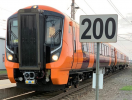bramling
Veteran Member
Does it in practice, though? When driving a car you need all round vision, including sideways and behind you. When driving a train you need to be able to see the signals, which are positioned in front of you.
Yes and no. If everything is well positioned then what you say is quite right. The difficulty is that this isn’t always the case, especially when one considers issues like platforms where the cab may stop close to a signal, or things like ground shunting signals. Here you then end up with a situation where signals aren’t in front of the driver like you say, but off to one side or low down. Repositioning of signals is costly and not always easy to achieve, so one can end up with issues.
Another issue is things like depot working, when the driver will be looking for hazards like staff on walkways. Here the driver may well need visibility to the extreme right and low down, for example. More of a problem if the driver is sitting further back from the window, which tends to be the case in newer gangway stock.
Cars aren’t much different. I have a 2000 BMW 5-Series and an equivalent 2016 model. The visibility on the latter is considerably worse for various reasons.
Last edited:


